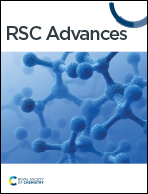Performance improvement of aqueous zinc batteries by zinc oxide and Ketjen black co-modified glass fiber separators†
Abstract
Rechargeable aqueous zinc-based batteries (AZBs) are intriguing candidates for next-generation energy storage batteries. However, the dendrites generated plagued their development during charging. To inhibit the dendrite generation, a novel modification method based on the separators was proposed in this study. The separators were co-modified by spraying sonicated Ketjen black (KB) and zinc oxide nanoparticles (ZnO) uniformly. The highly conductive KB homogenizes the anode interface's electric field. The deposited ions are deposited on ZnO preferentially rather than on the anode electrode, and the deposited particles can be refined. The ZnO in the uniform KB conductive network can provide sites for zinc deposition, and the by-products of the zinc anode electrode reduced. The Zn-symmetric cell with the modified separator (Zn//ZnO–KB//Zn) can cycle for 2218 h at 1 mA cm−2 stably (the unmodified Zn-symmetric cell (Zn//Zn) only can cycle for 206 h). With the modified separator, the impedance and polarization of Zn//MnO2 reduced, and the cell can charge/discharge 995 times at 0.3 A g−1. In conclusion, the electrochemical performance of AZBs can be improved effectively after separator modification by the synergistic effect of ZnO and KB.



 Please wait while we load your content...
Please wait while we load your content...